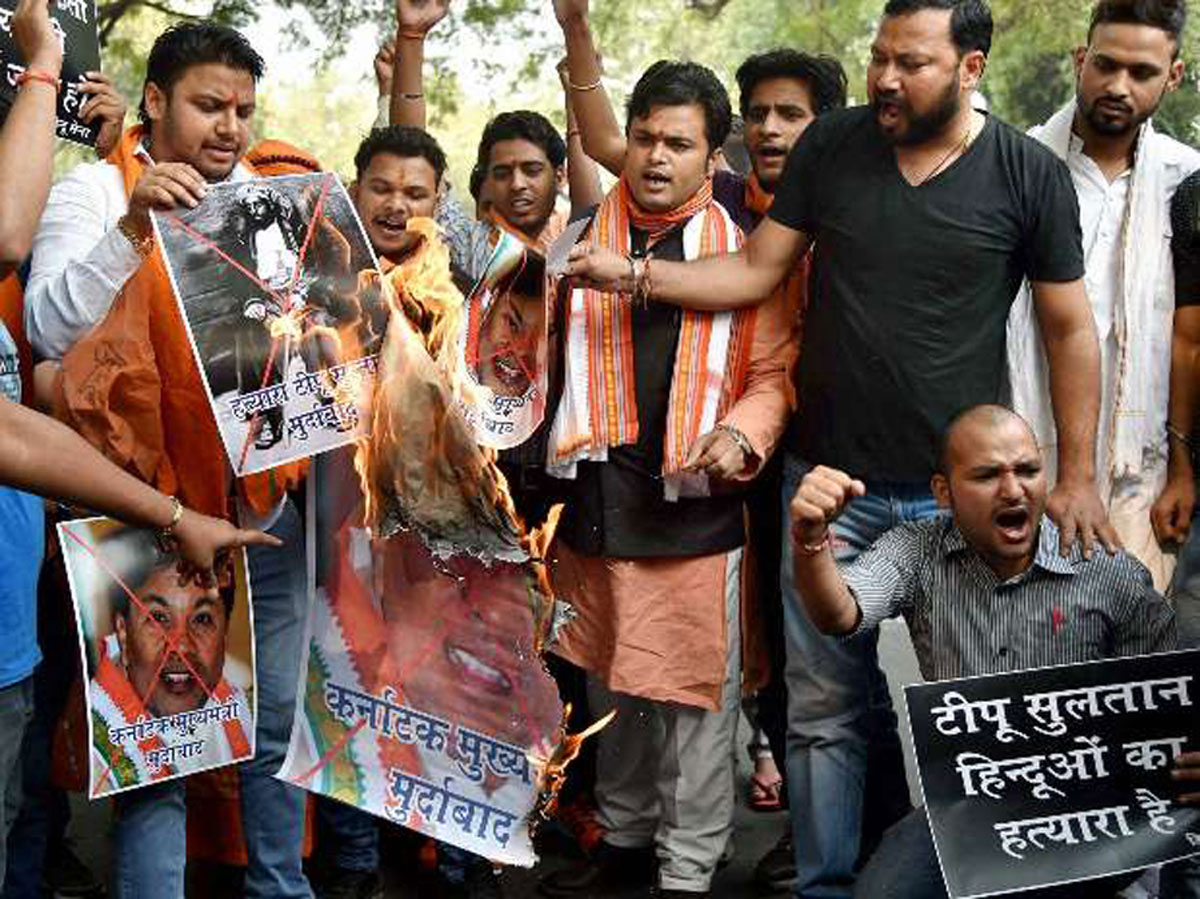THE ‘TIPU JAYANTI CUP’ STIR
Activists burning an effigy of Karnataka Chief Minister S. Siddaramaiah, in New Delhi. (Press Trust of India)
Massive protests, public anxiety and downright hostilities erupted with the announcement of the celebration of the 265th birth anniversary of “The Tiger of Mysore” or Tipu Sultan (full name Sultan Fateh Ali Khan Shahab), the ruler of the Kingdom of Mysore from 1782 to 1799, on Nov. 10 by the Siddaramaiah-led Congress government in the southern province of Karnataka, writes Priyanka Bhardwaj. (Society, @Siliconeer, #Siliconeer)
Dissenting groups adamantly opposed the state’s decision to observe “Tipu Jayanti” (jayanti meaning birth anniversary), foremost among them the right wing supporters of the Bharatiya Janata Party and other Sangh affiliates that leveled allegations of annihilation or forceful conversions of rebel Hindus and Syrian Christians in Coorg and Malabar and the desecration of Hindu temples in southern Karnataka and northern Kerala by the Sultan of Mysore.
This profiling, however, stands at odds with modern day supporters of Tipu who cite historical documents highlighting his financial aid to 136 Hindu temples, and also bestow on him the honor of a “nationalist” and “patriot” for having waged a zealously fought anti-British war in the Deccan to keep the foreigners at bay.
Clamor between these two hard line groups moved beyond political jousting when four Vishwa Hindu Parishad (VHP) workers died and scores of others injured during an intervention by the police, tasked with the responsibility to prevent any untoward incident when a Muslim group took out a procession to venerate Tipu in Kushalnagar (a town in Karnataka).
In retaliation the VHP supporters imposed a “bandh” (general shutdown) throughout the state impacting general life and commerce.
Tipu Sultan, who stands at the epicenter of this debate enjoys a significant space in Deccan memory and is said to have been named after the local saint Tipu Mastan Aulia by his parents, Hyder Ali and mother Fatima Fakhr-Un-Nisa, Tipu Sultan.
![Page Pri Tipu 02 Portrait of Tipu Sultan once owned by Richard Colley Wellsley, now in the care of the British Library. [Cicra 1792]. (Wikimedia Commons)](https://siliconeer.b-cdn.net/current/wp-content/uploads/2015/12/PAGE-PRI-TIPU-02.jpg)
The first mention of Tipu grabbing public attention was when at an early age of 15 he captured the family of the Malabar chief with just about a couple of thousand military followers.
Later it his wreaking havoc among advancing British military ranks (imperialist British East India Company), and his eventual martyr in the Fourth Anglo-Mysore War, while valiantly defending his Fort at Srirangapatna in the May of 1799 against the combined forces of the British, Marathas of the central-west and the Nizam of Hyderabad that catapulted him to become an iconic figure.
Yet, with the passage of time the characterization of his persona and activities sunk under layers of assessments and interpretations.
For colonial scholars it was a given that Tipu be portrayed as a “fanatic oriental despot” who fought to sustain his autocracy with sheer might as a result of which he failed to win any wholesome loyalty even among friends, and entertained no scruples aligning with other foreigners like the Turks, Afghans and French against the British.
The British Commission, established soon after the death of Tipu, even found him guilty of undertaking oppressive campaigns against “kafirs” or non believers of Islam, the religion he adhered to, and “Islamizing” names of places across Malabar, Mangalore, Calicut, Cannanore and Belapore.
The Malabar Manual by William Logan in particular mentions the destruction of several Hindu temples during the Mysore rule.
At variance with the above depiction of Tipu are the post-colonial authors who hail him as a courageous and imaginative, national hero, and base their interpretations on Tipu’s projects of modernization: comprehensive land revenue system, giving tax breaks, establishing trading posts throughout his dominions, promoting agriculture and sericulture, repairing and building new irrigation infrastructure; of developing unique methods of warfare; his penchant for astronomy, an un-Islamic pursuance; and for making numerous endowments to Sringeri Matth (an important Hindu monastery), after it was raided by the Marathas in 1791, and the glorious continuum of Sri Ranganatha Swami temple in Srirangapatna under his reign.
Therefore, as we may find enough evidences to support the two competing evidences what becomes important is to contextualize Tipu’s personality and actions in the medieval times of kingship, when there was no such thing as the identity of “India,” nor any understanding of human rights as agreed upon in modern parlance.
Hence, both vilification and veneration would be rendered fruitless pursuits.
However, perhaps in a great hurry to spot a red herring in the Tipu Jayanti, Siddaramaiah missed to check the correct date of birth of Tipu, that is November 20, and not November 10!
Still the civil society and public at large became mute spectators to the deliberate drama as right wing activists picked up a red rag in the Muslim ruler and a few seized the opportunity to issue death threat to eminent playwright and Jnanpith award-winner, Girish Karnad for suggesting that the Bengaluru airport be named after Tipu Sultan.
It is another matter that the controversy and enigma fetched the British Museum a whopping sum when Tipu’s sword was sold off at an auction to an Indian tycoon, Vijaya Mallya.
But for days to come it may be regarded as a foregone conclusion that no national agreement is likely to surface on historical personalities and occurrences.
Yet it is a reasonable expectation that there be a widening of historical content, by evaluation of available evidence along new levels of rationality and objectivity to open newer channels through sensitive areas.
Or else constant linking of historical grievances with modern politics will portent dangerous zero sum games for the Indian socio-political milieu.


